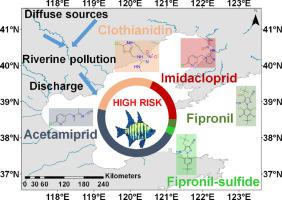Water Research ( IF 12.8 ) Pub Date : 2021-11-30 , DOI: 10.1016/j.watres.2021.117912 Tanja Naumann 1 , Célia P M Bento 1 , Andreas Wittmann 1 , Juergen Gandrass 1 , Jianhui Tang 2 , Xiaomei Zhen 3 , Lin Liu 3 , Ralf Ebinghaus 1

|
Systemic insecticides like neonicotinoids and the phenylpyrazole insecticide fipronil are the most widely applied insecticides around the world. Multiple studies analyzed insecticide residues in freshwater systems, but data on seawater contamination levels are scarce. This study investigates the spatiotemporal distribution and ecological risk assessment of fipronil, neonicotinoids, sulfoxaflor and selected transformation products (TPs) in the Chinese Bohai Sea and its surrounding rivers. Well-established neonicotinoids (acetamiprid, clothianidin, imidacloprid, thiacloprid and thiamethoxam) and TPs of fipronil and imidacloprid were frequently detected (detection frequency (DF): 42-100%) in freshwater. The median total insecticide concentration in freshwater was significantly higher in summer (72.4 ng•L-1) than in fall (23.4 ng•L-1), with major contributions from neonicotinoids, suggesting that pollution originates mostly from diffuse sources. In 2018, acetamiprid, desnitro-imidacloprid, fipronil-desulfinyl and thiacloprid were abundant in seawater (DF: 47–100%), indicating a high stability of acetamiprid and thiacloprid and a rapid photodegradation of fipronil and imidacloprid in surface waters. These results indicate that the continued use of these parent compounds may lead to their accumulation and/or of their TPs in shallow coastal seas. Consequently, this may lead to their transport to open seas, increasing their potential risk to marine organisms. Similarities between contaminant fingerprints in freshwater and seawater strongly suggest riverine discharges as main pollution source of adjacent coastal areas. This is the first study to perform an ecological risk assessment of fipronil, neonicotinoids, sulfoxaflor and selected TPs on marine ecosystems. Fipronil and its TPs demonstrated to be environmentally relevant with potential high risks for aquatic species. Our study provides novel insights into the fate and ecological risk of fipronil, neonicotinoids, sulfoxaflor and their TPs to marine species in shallow coastal seas.


























 京公网安备 11010802027423号
京公网安备 11010802027423号